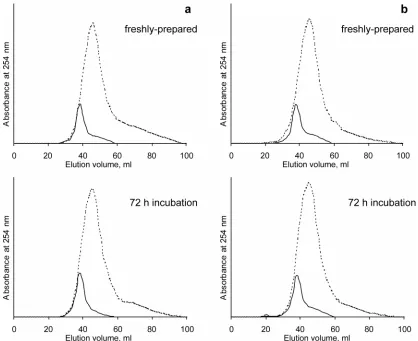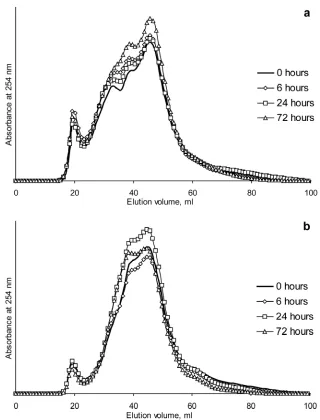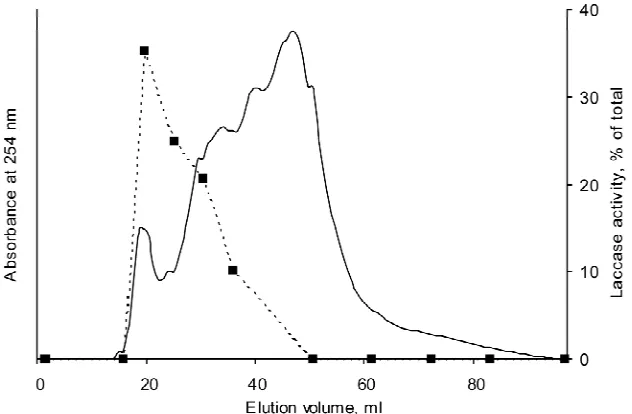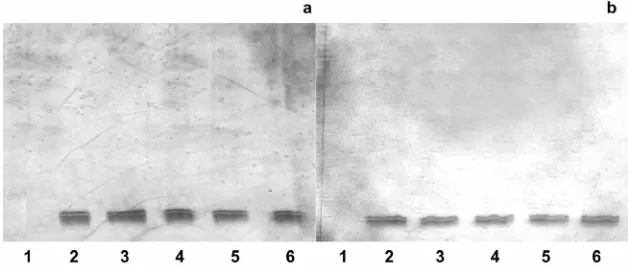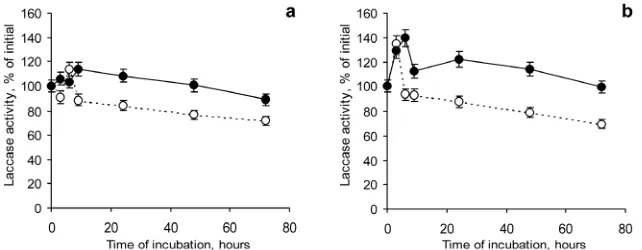Interaction of Coal Humic Acids with Fungal Laccase
Natalia A. Kulikova1,2*, Valentina N. Davidchik2, Eugenia A. Tsvetkova3, Olga V. Koroleva2 1Department of Soil Science, M.V. Lomonosov Moscow State University, Moscow, Russia
2A.N. Bach Institute of Biochemistry, Moscow, Russia 3N.D. Zelinskii Institute of Organic Chemistry, Moscow, Russia
Email: *knat@darvodgeo.ru
Received March 4, 2013; revised April 4, 2013; accepted May 4, 2013
Copyright © 2013 Natalia A. Kulikova et al. This is an open access article distributed under the Creative Commons Attribution Li-cense, which permits unrestricted use, distribution, and reproduction in any medium, provided the original work is properly cited.
ABSTRACT
Humic acids (HA) are one of the main environmental factors controlling the fate and behavior of the compounds re- leased into the environment. In particular, they are universally considered of great importance in determining soil ex- tracellular enzyme activity and stability via association with essential soil enzymes. The objective of this study was to investigate the interaction of coal HA with an extracellular multicopper oxidase laccase (EC 1.10.3.2) that catalyze the oxidation of a wide range of reducing substances in the environment. Using size-exclusion chromatography analysis and monitoring laccase activity, the formation of a stable and an enzymatically active complex between HA and laccase was shown. Basing the data obtained by isoelectric focusing of HA-laccase complex, non-covalent character of laccase association with HA was considered and binding of laccase to HA by weak dispersive forces such as van der Waals, hydrophobic, π-π, CH-π and others was hypothesized.
Keywords: Humic Acids; Laccase; Activity; Size-Exclusion Chromatography; Complexes; Isoelectric Focusing
1. Introduction
Humic substances (HS) are ubiquitous natural compounds comprising the major component of soil organic matter and sediments, as well as aquifers [1-3]. By the chemical nature HS can be considered to be irregular polymers of aromatic polyhydroxyl carbonic acids [3], and the pecu-liarity of the structure of HS consists of a coexistence of both polar and hydrophobic environments in the same molecule. As a result, HS are able to bind both polar and hydrophobic organic compounds and inorganic ions as well. Thus, HS are one of the main environmental factors controlling the fate and behavior of the compounds re-leased into the environment. In particular, they are uni-versally considered of great importance in determining soil extracellular enzyme activity and stability via asso-ciation with essential soil enzymes such as ureases, pro-teases, phosphatases, hydrolases, laccases, and peroxidases, which have been detected in soil extracts as complexes with HS [4,5]. Contrary to the extracellular enzymes in-corporated into a soil mineral matrix, where they often loose their activity, humus-immobilized enzymes can fre-quently retain their activity and display stability against environmental stresses.
Laccases (EC 1.10.3.2) are extracellular multicopper oxidases that catalyze the oxidation of a wide range of reducing substances with the concomitant reduction of
O2. Because of their capability of oxidizing aromatic
compounds, such as phenols and anilines, laccases have promising potential as industrial enzymes for various applications, such as wood fiber modification, biosensor construction, and water and soil remediation [6-10]. Re-cently laccase-based biocatalysis has been expanded, with the aid of small “mediators”, to pulp delignification [11- 13], textile dye bleaching [14,15], polycyclic hydrocar-bon degradation [16-20], destruction of pesticide, insec-ticide, or chemical warfare [21-23], and organic synthesis [24,25]. Nowadays a special attention is paid to laccase in relation to so-called enzymatic treatment, which is currently considered as an alternative method for the re-moval of toxic xenobiotics from the environment [8,10]. Enzyme-mediated transformation reactions may result in formation of compounds where xenobiotics bind cova-lently to HS via oxidative coupling [26,27].
Despite the abundance of promising experimental data, a number of limitations still restrict the use of laccase to detoxify xenobiotics. One of them is a lack of knowledge in the field of laccase interaction with HS, which can influence both on the enzyme activity and stability in the
environment. Only a few studies are available now in literature [28,29], and an investigation of association of HS with laccase is therefore of great interest. The objec-tive of this research was to investigate laccase interaction with HS in a model system containing laccase and coal humic acids (HA) and to get insight into the nature of HA-laccase complex.
2. Experimental
2.1. Humic Acids
Humic acids (HA) used in this study was a commercial preparation of leonardite HA “Powhumus” (Humintech, Germany). Elemental analysis of HA was determined with a Carlo Erba Strumentazione analyzer and showed that HA contained (on ash-free and moisture-free bases) 45.9% C, 3.4% H, and 1.6% N. Ash content was 1.1%. Content of carboxylic and phenolic groups determined using potentiomentric titration technique was 2.9 and 3.0 mekv/g, respectively [30].
2.2. Laccase Isolation and Characterization
For this study laccase form the strain of Trameteshirsuta
(Wulf.:Fr.) Pil. 072 was used. The fungal strain was kindly provided by Komarov Botanical Institute (St. Pe-tersburg, Russia) and cultivated as described earlier [31]. Extracellular laccase was isolated from the culture me-dium and purified in accordance with [32]. The control of laccase homogeneity was carried out with polyacryla-mide gel (PAAG) electrophoresis under non-denaturing conditions as described in [33]. The pH optima of the major isoenzyme determined using pyrocatechol as sub-strate was 4.5 [32].
2.3. HA-Laccase Complexes Preparation and Monitoring
The HA-laccase complexes were prepared by incubation (27˚C, 72 hours) of laccase and HA together at
concen-trations of 100 and 40 mg·l−1, respectively. A 50 mM
potassium phosphate buffer at pH 5.0 or 6.5 was used as a background electrolyte. In parallel, control solutions of laccase and HA solely were incubated under the same conditions. Because of the observed biodegradation of laccase (data not shown) toluene was added to the solu-tions to suppress microbial activity [34]. After 6, 24, 48, and 72 hours of incubation solutions were sampled for size-exclusion chromatography analysis. Additionally, dur-ing the incubation laccase activity and protein concentra-tions were monitored at regular intervals (after 1, 3, 6, 9, 12, 24, 48 and 72 hours). For isoelectric focusing laccase with HA were incubated at the same conditions, but for longer period of time (168 hours) and using higher con-centrations of the compounds. Namely, concentration for
laccase was 1000 mg·l−1 and for HA 400 mg·l−1.
2.4. Fractionation of the HA-Laccase Complexes by Size-Exclusion Chromatography (SEC)
SEC analysis was performed according to [35]. SEC system Abimed (Gilson, France) was equipped with on- line UV detector and included HPLC pump, auto sampler, and glass column. The column 25 mm × 20 cm packed with Toyopearl TSK HW-55S gel (Toso Haas, Japan) was used for separation. The 0.028 M phosphate buffer (pH 6.8) was used as a mobile phase. The flow rate was set at 1 ml·min−1. The absorbance of eluate was detected
at 254 nm. A void volume (V0 = 19.2 ml) and a total
permeation volume (Vt = 74.5 ml) of the column were
determined using Blue Dextran 2,000,000 and acetone, respectively. Sodium polystyrene sulfonates (PSS) of mo-lecular weight of 2.29, 4.48, 14.00, 20.70, 45.10, and 80.84 kDa (Polymer Standard Service, Germany) were used as markers for molecular weight calculations. Data obtained was treated using approach published in [36]. To obtain laccase activity profiles of the HA-laccase complex 10-ml fractions were collected and analyzed for laccase activity.
2.5. Study HA-Laccase Complex Formation by Isoelecric Focusing (IEF)
To determine change of isoelectric point (pI) of laccase associated with HA compared to free laccase, IEF was carried out as described in [37]. Briefly, 20 l of solution of fresh prepared HA-laccase complex, HA-laccase complex after 72 or 168 hours of incubation, HA or lac-case without added HA was sampled and directly loaded in a standard PAAG (110 120 0.4 mm, T = 7.5%, C = 3%) containing 3% ampholytes pH 4.0 - 7.0 (Iso-Lyte 4 -
7, ICN Biomedicals). 1 M NaOH and 1 M H3PO4 were
used as cathodic and anodic buffers, respectively. IEF was conducted at constant power of 6 Wt and tempera-ture of 10˚C during 1.5 hours. Gels were stained with a solution of Coomassie Blue R-250.
2.6. Measurements of Laccase Activity
The laccase activity was determined spectrophotometri-cally or polarographispectrophotometri-cally. In case of spectrophotometric approach [32] laccase activity was measured by follow-ing the rate of oxidation of pyrocatechol to quinone by plotting the absorbance at 410 nm (A410) against time. A stock solution contained 10 mM pyrocatechol in 0.1 M sodium acetate buffer at pH 4.5. One unit of activity was defined as a change in A410 per min per mg of protein.
Polarographic assay of laccase activity was carried out using a Clark oxygen electrode in a hermetically sealed
sample chamber (final volume 0.7 ml) at 25˚C. The en-
SEC. SEC-profiles of HA and laccase solely did not
change within 72 hours (Figure 1) demonstrating their
stability during the time of the experiment. Chromatograms of both HA and laccase exhibited a sharp single symmet-ric peak. This finding confirms that the SEC-fractiona- tion was conducted under conditions appropriate for the substances under study, as no artifacts such as ionic ex-clusion or specific adsorption were observed [35,38]. That was also indicative for complete suppression of the surface negative charge of HA (ibid.). Observed values of elution volume for HA [45.4 ml] and laccase [38.4 ml] corresponded to the peak molecular weight (MW) values of 9.6 and 21.9 kD respectively. The MW of laccase from T.hirsuta determined earlier using standard
globu-lar protein calibration kit was reported to be 55 kD [39], what was considerably higher than obtained in our ex-periments. The observed variance in MW values can be attributed to the difference in SEC system such as the charge density of the used calibrants. In particular, in [35] it was shown that the smaller the charge density of the chosen calibrants, the higher the values of MW will be. zymatic reaction was initiated by the addition of laccase
solution to 4 10−5 M syringaldazine (4-hydroxy-3,5- dimethoxybenzaldehyde azine) in 0.1 M sodium acetate buffer at pH 4.5. Laccase final concentration in the sam-ple chamber was 25 nM. The initial oxygen concentra-tion was 260 µM (according to the evaluaconcentra-tion of the Henry coefficient). One unit of enzymatic activity was defined as the amount of laccase required for consump-tion 1 mol·min−1 of O
2.
Protein concentration was measured with a use of bi-cinchoninic acid (BCA) protein assay kit (Pierce, USA).
2.7. Statistical Data Treatment
All results were presented as mean ± SD. Comparison between two means was performed using unpaired Stu-dent’s t-test. Differences were considered to be signifi-cant when p < 0.05.
3. Results and Discussion
3.1. HA-Laccase Association
[image:3.595.89.507.367.708.2]SEC-profiles of HA-laccase complexes at different pH are presented in Figure 2. The chromatograms consisted Association of laccase with HA was monitored using
Figure 2. SEC chromatograms of HA-laccase complexes after different time of incubation at pH 5.0 (a) and 6.5 (b).
of the first sharp peak followed by 2 - 3 diffused peaks. As it can be seen, profiles of HA-laccase complexes cannot be described as a superposition of SEC-profiles of these substances. Along with peaks corresponding to HA and laccase and additional peak at an elution volume equal to the V0 (19.2 ml) of the column appeared. Given that ionic exclusion arising from repulsive interaction between the charged analyte and the partially charged gel matrix can be excluded, a formation of HA-laccase com-plex with molecular weight larger that fractionation range of the SEC-system used should be proposed. Indeed, activity profile of laccase in the presence of HA obtained by SEC-fractionation of HA-laccase profile after 24 hours of incubation showed the main activity peak at the
elu-tion volume of about 20 ml (Figure 3). This behavior
was interpreted to be a result of the formation of a stable and enzymatically active complex between HA and
lac-case.
Polymerization of HA in the presence of laccase could be also surmised to be responsible for the observed addi-tional peak. Appearance of new HA peaks with corre-sponding peak MW of 18.8 and 40.9 kD at pH 5.0 (elu-tion volumes 39.6 and 32.3 ml) or with 18.8 kD at pH 6.5 (elution volume 39.6 ml) was also evident for the forma-tion of HA fracforma-tions with larger peak MW comparing with initial humic material. This is in agreement with recent results that have shown an increase in molecular size of humic matter following an oxidative polymeriza-tion reacpolymeriza-tion catalyzed by the peroxidase [40]. As laccase under study was demonstrated to have the maximum catalytic activity at pH 4.5 [39], the enzymatic activity was therefore supposed was greater at pH 5.0 than at 6.5. In comparison to pH 6.5, the intensity of the additional peak was higher at pH 5.0 (Figure 2). This finding could
Figure 3. SEC chromatogram and activity profile of HA-laccase complex at pH 5.0 after 24 hours of incubation. Firm line represents absorbance profile, dotted line represents activity profile.
be attributed to the greater HA polymerization under conditions of the higher enzymatic activity of laccase. However, quantitative evaluations are prone to errors be-cause of possible changes in the molar extinction coeffi-cients of components in fractions belonging to different peaks.
During the experiment a slight increase in intensity of absorbance of the diffused peaks was observed. Assum-ing that chromophores possessAssum-ing conjugated π-electron systems (e.g. C=C-C=C, C=C-C=O and aromatic com-pounds) mainly determined UV absorptivity at 254 nm, oxidation of HA in the presence of laccase following formation of quinonic structures from phenolic moieties in HA could be proposed. So, the observed polymeriza-tion of coal HA in the presence of laccase was possible due to the processes similar to the oxidative coupling of phenols.
Association of HA with laccase was supposed to alter pI of the enzyme due to formation of its complex with humics. Therefore, the IEF separation of the HA-laccase complex and laccase was conducted. The obtained results
are presented in Figure 4. IEF showed no HA band
un-der selected conditions, while for laccase a double band at pH ca 4.0 was observed reflecting the existence of two isoenzymes with close isoelectric points [39]. IEF of the blank solution containing laccase solely showed no changes in enzyme electrophoretic behavior during 7 days of in-cubation indicating laccase stability under selected con-ditions. It can be seen that over the experiment the pI of laccase in the HA-laccase complex did not change as compared to free laccase at both pH studied. In particular, neither appearance of an additional band nor its shift nor alteration in intensity of the bands was observed. This
finding was an evidence of non-covalent character of laccase association with HA, as covalent bond formation would result in HA-laccase complex stable under IEF conditions. On the other hand, ionic interactions between HA and enzyme was supposed to be negligible under selected conditions as HA-laccase complex remained sta- ble in SEC analysis where surface negative charge of HA was suppressed. The association between HA and laccase by weak dispersive forces such as van der Waals, hydro- phobic, π-π, CH-π and others was therefore hypothe- sized.
3.2. Dynamic of Laccase Activity in the Presence and Absence of Coal HA
Figure 4. IEF analysis of HA, laccase and HA-laccase complex after different time of incubation at pH 5.0 (a) and pH 6.5 (b). 1 - HA, 2, 3 -laccase after 0 and 168 hours of incubation, 4, 5, 6 - HA-laccase complex after 0, 72, and 168 hours of incubation.
Figure 5. Activity of laccase solely (Lac), in the presence of toluene (Lac + T) and in the presence of toluene and HA (Lac + T + HA) at pH 5.0 (a) and 6.5 (b). Bars represent standard deviations.
laccase [42,43]. Another possible reason for laccase in-activation could be a loss of water and/or unfolding of an enzyme in the presence of polar solvents [41]. Laccase from T.hirsuta contains 284 molecules of water
accord-ing to crystallographic study and the first assumption is rather reasonable. Besides, the difference in optical spec-tra of laccase solely and laccase with toluene was insig-nificant (data not shown). Therefore, only the nearest surrounding of the laccase active center was supposed to be affected by toluene.
In this study, coal HA did not have a negative effect
on laccase activity (Figure 5), what was in agreement
with recently published data [44]. The finding, neverthe-less, contradicted the reported data on the inhibitory ef-fect of coal HA on laccase [29]. The authors proposed that the inactivation of laccase was mainly due to deple-tion of the copper ion from the active site of the enzyme. However, it is widely accepted that laccase can loose its activity because of dissociation of Cu only in the pres-ence of a strong chelating agent under anaerobic condi-tions. Even for elimination of copper type 2 (the most easily eliminating copper ion from laccase) it is neces-sary to use guanidine chloride under denaturing condition followed by bathcuproine treatment [45,46]. In this study interaction of native laccase with HA under non-dena- turing conditions has been carried out.
Therefore, copper dissociation from laccase in the pre- sence of HA can hardly occur in our experiments.
The dynamic of laccase activity at pH 5.0 and 6.5 (Figure 6) was characterized with two stages, namely, with an activation and an inhibition stages. This effect supposed to be connected with a rearrangement of case active center as well as with inter transition of lac-case forms existing in the solution. The peak of maxi-mum laccase activity was observed within 1 - 3 hours for laccase both at pH 5.0 and pH 6.5. In the presence of HA the peak of activation was shifted to 12 hours at both pH studied. This finding was probably attributed to the con-formational changes in laccase structure due to its asso-ciation with HA.
On the second stage gradual decrease in enzyme activ-ity along with time of incubation was observed. Laccase activity after 72 hours of incubation decreased to 72% and 70% compared to initial activity at pH 5.0 and 6.5, respectively. In the presence of HA those values were 89% and 99%. Compared to the maximum-recorded val-ues of laccase activity, laccase activity at the end of ex-periment reduced to 63% or 52% at pH 5.0 or 6.5, while in the presence of HA enzyme activity was 78% and 71%, respectively. So, laccase activity was concluded to be stabilized in the presence of coal HA.
So, the complex formation between laccase and HA
Figure 6. Dynamics of laccase activity solely (dotted lines) and in the presence of HA (firm lines) at pH 5.0 (a) and 6.5 (b). Bars represent standard deviations.
with preservation of laccase activity has been established. Assuming the stability of HA-laccase complex under con-ditions that provided compensation of partial negative charge both of laccase and HA, ionic interaction between those compounds can be excluded. On the other hand, IEF data allowed concluding on the non covalent binding. The association between HA and laccase by weak dis-persive forces such as hydrophobic, van der Waals, π-π, and others was therefore hypothesized. The obtained data showed also that the interaction of laccase with HA in-cluded both complex formation and direct partial oxida-tion of HA structural fragments.
4. Acknowledgements
Authors thank Dr. Elena Stepanova for her kind assis-tance in fungi cultivation and laccase extraction and pu-rification and Elena Belyaeva for the SEC measurements. This work was partly supported by the Ministry of edu-cation and science of Russia in the framework of the Fe- deral Targeted Program “Scientific and research and edu- cational cadres of innovative Russia in 2009-2013” (Ag- reement #8111).
REFERENCES
[1] E. M. Thurman, “Organic Geochemistry of Natural Wa-ters,” Martinus Nijhof/Dr. W. Junk Publishers, Dordrecht, 1985.
[2] D. S. Orlov, “Soil Humic Acids and General Theory of Humification”, Moscow State University Publisher, Mos- cow, 1990.
[3] C. E. Clapp, M. H. B. Hayes and R. S. Swift, “Isolation, Fractionation, Functionalities, and Concepts of Structure of Soil Organic Macromolecules,” In: A. J. Beck, K. C. Jones, M. B. H. Hayes and U. Mingelgrin, Eds., Organic Substances in Soil and Water: Natural Constituents and Their Influence on Contaminant Behaviour, Royal Soci-ety of Chemistry, Cambridge, 1993, pp. 31-69.
[4] G. Masciandaro and B. Ceccanti, “Assessing Soil Quality in Different Agro-Ecosystems through Biochemical and Chemico-Structural Properties of Humic Substances,” Soil
and Tillage Research, Vol. 51, No. 1-2, 1999, pp. 129- 137. doi:10.1016/S0167-1987(99)00056-2
[5] E. Benitez, H. Sainz and R. Nogales, “Hydrolytic Enzyme Activities of Extracted Humic Substances during the Vermicomposting of a Lignocellulosic Olive Waste,” Bio-resource Technology, Vol. 96, No. 7, 2005, pp. 785-790. doi:10.1016/j.biortech.2004.08.010
[6] A. Messerschmidt, “Multi-Copper Oxidases,” World Sci- entific, Singapore, 1997.
[7] F. Xu, “Recent Progress in Laccase Study: Properties, Enzymology, Production, and Applications,” In: M. C. Flickinger and S. W. Drew, Eds., Encyclopedia of Bio-processing Technology: Fermentation, Biocatalysis, and Bioseparation, John Wiley & Sons, New York, 1999, pp. 1545-1554.
[8] L. Gianfreda, F. Xu and J.-M. Bollag, “Laccases: A Use-ful Group of Oxidoreductive Enzymes,” Bioremediation Journal, Vol. 3, No. 1, 1999, pp. 1-25.
[9] S. A. Gomes, J. M. Nogueira and M. J. Rebelo, “An Am-perometric Biosensor for Polyphenolic Compounds in Red Wine,” Biosensors and Bioelectronics, Vol. 20, No. 6, 2004, pp. 1211-1216. doi:10.1016/j.bios.2004.05.013 [10] T. Sonoki, S. Kajita, S. Ikeda, M. Uesugi, K. Tatsumi, Y.
Katayama and Y. Iimura, “Transgenic Tobacco Express-ing Fungal Laccase Promotes the Detoxification of Envi-ronmental Pollutants,” Applied Microbiology and Bio-technoogy, Vol. 67, No. 1, 2005, pp. 138-142.
doi:10.1007/s00253-004-1770-8
[11] R. Bourbonnais and M. G. Paice, “Enzymatic Delignifi-cation of Kraft Pulp Using Laccase and a Mediator,” Tappi Journal, Vol. 79, No. 6, 1996, pp. 199-204. [12] C. L. Crestini and D. S. Argyropoulos, “The Early
Oxida-tive Biodegradation Steps of Residual Kraft Lignin Mod-els with Laccase,” Bioorganic and Medicinal Chemistry, Vol. 6, No. 11, 1998, pp. 2161-2169.
doi:10.1016/S0968-0896(98)00173-4
[13] A. Ortega-Clemente, C. Estrada-Vazquez, F. Esparza- Garcia, S. Caffarel-Mendez, N. Rinderknecht-Seijas and H. M. Poggi-Varaldo, “Integrated Biological Treatment of Recalcitrant Effluents from Pulp Mills,” Water Science and Technology, Vol. 50, No. 3, 2004, pp. 145-156. [14] P. Schneider and A.H. Pedersen, “Enhancement of
[15] R. C. Senan and T. E. Abraham, “Bioremediation of Tex-tile Azo Dyes by Aerobic Bacterial Consortium—Aerobic Degradation of Selected Azo Dyes by Bacterial Consor-tium,” Biodegradation, Vol. 15, No. 4, 2004, pp. 275-280. doi:10.1023/B:BIOD.0000043000.18427.0a
[16] S. Böhmer, K. Messner and E. Srebotnik, “Oxidation of Phenanthrene by a Fungal Laccase in the Presence of 1- hydroxybenzotriazole and Unsaturated Lipids,” Bioche- mical and Biophysical Research Communications, Vol. 244, No. 1,1998, pp. 233-238.
doi:10.1006/bbrc.1998.8228
[17] M. A. Pickard, R. Roman, R. Tinoco and R. Vazquez- Duhalt, “Polycyclic Aromatic Hydrocarbon Metabolism by White Rot Fungi and Oxidation by Coriolopsis gallica UAMH 8260 Laccase,” Applied and Environmental Mi-crobiology, Vol. 65, No. 9, 1999, pp. 3805-3809. [18] C. Johannes, A. Majcherczyk and A. Hüttermann,
“Deg-radation of Anthracene by Laccase of Trametes versicolor in the Presence of Different Mediator Compounds,” Ap-plied Microbiology and Biotechnology, Vol. 46, No. 3, 1996, pp. 313-317.
[19] A. Majcherczyk, C. Johannes and A. Hüttermann, “Oxi-dation of Polycyclic Aromatic Hydrocarbons (PAH) by Laccase of Trametes versicolor,” Enzyme and Microbial Technology, Vol. 22, No. 5, 1998, pp. 335-341.
doi:10.1016/S0141-0229(97)00199-3
[20] M. J. Han, H. T. Choi and H. G. Song, “Degradation of Phenanthrene by Trametes versicolor and Its Laccase,” Journal of Microbiology, Vol. 42, No. 2, 2004, pp. 94-98. [21] F. S. Sariaslani, J. M. Beale Jr. and P. Rosazza, “Oxida-tion of Rotenone by Polyporus anceps Laccase,” Journal of Natural Products, Vol. 47, No. 4, 1984, pp. 692-697. [22] G. Amitai, R. Adani, G. Sod-Moriah, I. Rabinovitz, A.
Vincze, H. Leader, B. Chefetz, L. Leibovitz-Persky, D. Friesem and Y. Hadar, “Oxidative Biodegradation of Pho- sphorothiolates by Laccase,” FEBS Letters, Vol. 438, No. 3, 1998, pp. 195-200.
doi:10.1016/S0014-5793(98)01300-3
[23] S. Kawai, T. Umezawa and T. Higuchi, “Oxidation of Methoxylated Benzyl Alcohols by Laccase of Coriolus versicolor in the Presence of Syringaldehyde,” Wood Re-search, Vol. 76, 1989, pp. 10-16.
[24] E. Fritz-Langhals and B. Kunath, “Synthesis of Aromatic Aldehydes by Laccase-Mediator Assisted Oxidation,” Te- trahedron Letters, Vol. 39, No. 33, 1998, pp. 5955-5956. doi:10.1016/S0040-4039(98)01215-5
[25] A. Potthast, T. Rosenau, C. L. Chen and J. S. Gratzl, “A Novel Method for the Conversion of Benzyl Alcohols to Benzaldehydes by Laccase-Catalysed Oxidation,” Jour-nal of Molecular Catalysis A: Chemical, Vol. 108, No. 1, 1996, pp. 5-9. doi:10.1016/1381-1169(95)00251-0 [26] K.-H. Kang, J. Dec, H. Park and J.-M. Bollag,
“Trans-formation of the Fungicide Cyprodinil by a Laccase of Trametes villosa in the Presence of Phenolic Mediators and Humic Acid,” Water Research, Vol. 36, No. 19, 2002, pp. 4907-4915. doi:10.1016/S0043-1354(02)00198-7 [27] M.-Y. Ahn, J. Dec, J.-E. Kim and J.-M. Bollag,
“Treat-ment of 2,4-dichlorophenol Polluted Soil with Free and Immobilized Laccase,” Journal of Environmental Quality, Vol. 31, No. 5, 2002, pp. 1509-1515.
[28] R. M. Fakoussa and P. J. Frost, “In Vivo Decolorisation of Coal-Derived Humic Acids by Laccase Excreting Fungus Trametes versicolor,” Applied Microbiology Biotechnol-ogy, Vol. 52, No. 1, 1999, pp. 60-65.
[29] Y.-S. Keum and Q. X. Li, “Copper Dissociation as Me- chanism of Fungal Laccase Denaturation by Humic Acid,” Applied Microbiology and Biotechnology, Vol. 64, No. 4, 2004, pp. 588-592. doi:10.1007/s00253-003-1460-y [30] A. N. Kovalenko, M. V. Youdov, I. V. Perminova and V.
S. Petrosyan, “Synthesis and Characterization of Humic Derivatives Enriched with Hydroquinoic and Catecholic Moieties,” Proceedings of the XII International Meeting of IHSS Humic Substances and Soil and Water Environ-ment, Sao-Pedro, 25-30 July 2004, pp. 472-473.
[31] O. V. Koroleva, E. V. Stepanova, V. P. Gavrilova, N. S. Yakovleva, E. O. Landesman, I. S. Yavmetdinov and A. I. Yaropolov, “Laccase and Mn-peroxidase Production by Coriolus hirsutus Strain 075 in a Jar Fermenter,” Journal of Bioscience and Bioengineering, Vol. 93, No. 5, 2002, pp. 449-455.
[32] O. Koroleva (Skorobogat’ko), E. Stepanova, V. Gavrilova, O. Morozova, N. Lubimova, A. Dzchafarova, A. Yaro-polov and A. Makower, “Purification and Characteriza-tion of the Constitutive Form of Laccase from the Basi- diomycete Coriolus hirsutus and Effect of Inducers on Laccase Synthesis,” Biotechnology and Applied Bioche- mistry, Vol. 28, No. 1, 1998, pp. 47-54.
[33] R. Westermeier, “Electrophoresis in Practice,” VCH Ver-lagsgesellschaft, Weinheim and VCH Publishers Inc., New York, 2001.
[34] C. G. Kowalenko, L. J. P. van Vliet, G. Derksen and S. Yu, “Limitations of Methods for Preserving Ammonium in Agricultural Runoff Samples,” Canadian Journal of Soil Science, Vol. 82, No. 4, 2002, pp. 439-444.
[35] I. V. Perminova, F. H. Frimmel, D. V. Kovalevskii, G. Abbt-Braun, A. V. Kudryavtsev and S. Hesse, “Develop- ment of a Predictive Model for Calculation of Molecular Weight of Humic Substances,” Water Research, Vol. 32, No. 3, 1998, pp. 872-881.
doi:10.1016/S0043-1354(97)00283-2
[36] A. V. Kudryavtsev, I. V. Perminova and V. S. Petrosyan, “Size-exclusion Chromatographic Descriptors of Humic Substances,” Analytica Chimica Acta, Vol. 407, No. 1-2, 2000, pp. 193-202. doi:10.1016/S0003-2670(99)00814-4 [37] P. G. Righetti, “Isoelectric Focusing: Theory, Methodol-
ogy and Applications,” Elsevier Biomedical Press, Am- sterdam, 1983.
[38] I. V. Perminova, “Size-Exclusion Chromatography of Hu- mic Substances: Complexities of Data Interpretation At- tributable to Non-size Exclusion Effects,” Soil Science, Vol. 164, No. 11, 1999, pp. 834-840.
doi:10.1097/00010694-199911000-00008
[39] O. V. Koroleva (Skorobogat’ko), E. V. Stepanova, V. P. Gavrilova, V. I. Biniukov, A. I. Jaropolov, S. D. Varfo- lomeyev, F. Scheller, A. Makower and A. Otto, “Lac- case of Coriolus zonatus Isolation, Purification and Some Physico-Chemical Properties,” Biotechnology and App- lied Biochemistry, Vol. 76, No. 2, 1999, pp. 115-127. [40] A. Cozzolino and A. Piccolo, “Polymerization of Dis-
solved Humic Substances Catalyzed by Peroxidase. Ef-
fects of pH and Humic Composition,” Organic Geoche- mistry, Vol. 33, No. 3, 2002, pp. 281-294.
doi:10.1016/S0146-6380(01)00160-7
[41] S. H. Van Erp, E. O. Kamenskaya and Y. L. Khmelnitsky, “The Effect of Water Content and Nature of Organic Sol- vent on Enzyme Activity in Low-Water Media. A Quan-titative Description,” European Journal of Biochemistry, Vol. 202, No. 2, 1991, pp. 379-384.
doi:10.1111/j.1432-1033.1991.tb16385.x
[42] J. Rodakiewicz-Nowak, J. Haber, N. Pozdnyakova, A. Leontievsky and L. A. Golovleva, “Effect of Ethanol on Enzymatic Activity of Fungal Laccases,” Bioscience Re- ports, Vol. 19, No. 6, 1999, pp. 589-600.
doi:10.1023/A:1020223130115
[43] J. Rodakiewicz-Nowak, “Phenols Oxidizing Enzymes in Water-Restricted Media,” Topics in Catalysis, Vol. 11-12, No. 1-4, 2000, pp. 419-434.
doi:10.1023/A:1027291629302
[44] U. Temp, H. Meyrahn and C. Eggert, “Extracellular Phe- nol Oxidase Pattern during Depolymerization of Low- Rank Coal by Three Basidiomycetes,” Biotechnology Let- ters, Vol. 21, No. 4, 1999, pp. 281-287.
doi:10.1023/A:1005491818192
[45] R. McMillin and M. K. Eggleston, “Bioinorganic Chemi- stry of Laccase,” In: Messerschmidt, Ed., Multicopper Oxidases, World Scientific, Singapore, 1997, pp. 129- 166.
